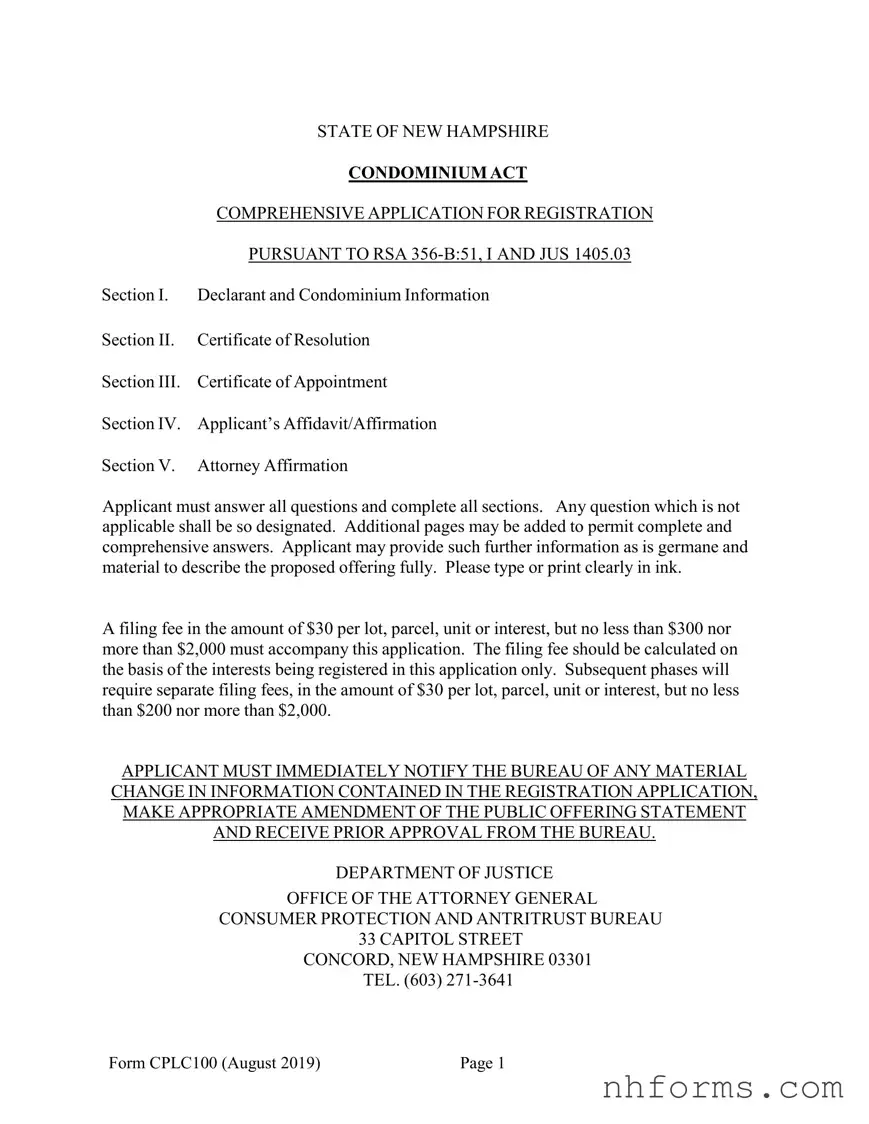What is the purpose of the New Hampshire Condominium Act Comprehensive Application for Registration?
The New Hampshire Condominium Act Comprehensive Application for Registration serves as a detailed form that developers or declarants must complete to register a condominium project with the state. This registration is mandated under RSA 356-B:51, I and JUS 1405.03. The form requires comprehensive information about the condominium, including details about the declarant, condominium specifications, financial arrangements, and legal compliance. Its primary goal is to ensure transparency, compliance with state laws, and protection for potential buyers.
Who is required to fill out this form?
This form must be filled out by the declarant of a condominium project in New Hampshire. A declarant can be an individual, group, or entity that seeks to register a condominium for legal recognition by the state. It could also include developers or agents acting on behalf of the condominium project. If you are involved in the creation, sale, or management of a condominium, you might need to complete this application to comply with state regulations.
What sections are included in the application?
The application is divided into several key sections: Declarant and Condominium Information, Certificate of Resolution, Certificate of Appointment, Applicant’s Affidavit/Affirmation, and Attorney Affirmation. These sections gather detailed information about the condominium project, legal resolutions, appointed officials, and legal affirmations from both the applicant and an attorney. They cover a wide range of information, from basic contact details to comprehensive legal documents.
Is there a filing fee?
Yes, there is a filing fee associated with this application. The fee is $30 per lot, parcel, unit, or interest, but not less than $300 and not more than $2,000. This fee is calculated based on the number of interests being registered. For subsequent phases of a project, separate filing fees must be paid under the same scale. This fee supports the processing and review of the application by the state.
What happens if there is a material change in information after submission?
If there is any material change in information after submission, the applicant must immediately notify the Bureau. This includes changes in the public offering statement or any other relevant details in the registration application. An appropriate amendment will be required, and prior approval from the Bureau must be obtained. Staying compliant involves keeping all provided information up-to-date.
What is the significance of the Certificate of Resolution and Certificate of Appointment?
The Certificate of Resolution and Certificate of Appointment are essential parts of the application process. They serve as official documents to confirm the resolutions passed by the governing body of the condominium and the appointment of key officials, respectively. These sections ensure that the condominium's governance is in accordance with state laws and that responsible individuals are appointed to oversee the project's adherence to legal and regulatory standards.
How do applicants provide additional information if required?
Applicants are encouraged to add additional pages to the application to provide complete and comprehensive answers. Moreover, they can provide further information that is germane and material to fully describe the proposed offering. This flexibility ensures that the state has a thorough understanding of the condominium project, which aids in the evaluation process.
What is the role of the Attorney Affirmation in the application?
The Attorney Affirmation is a critical component of the application, wherein an attorney affirms the accuracy and completeness of the information provided. This section is crucial for ensuring that the application adheres to legal standards and that the condominium project complies with state laws. It reflects due diligence on the part of the applicant and provides an additional layer of verification to the state.








